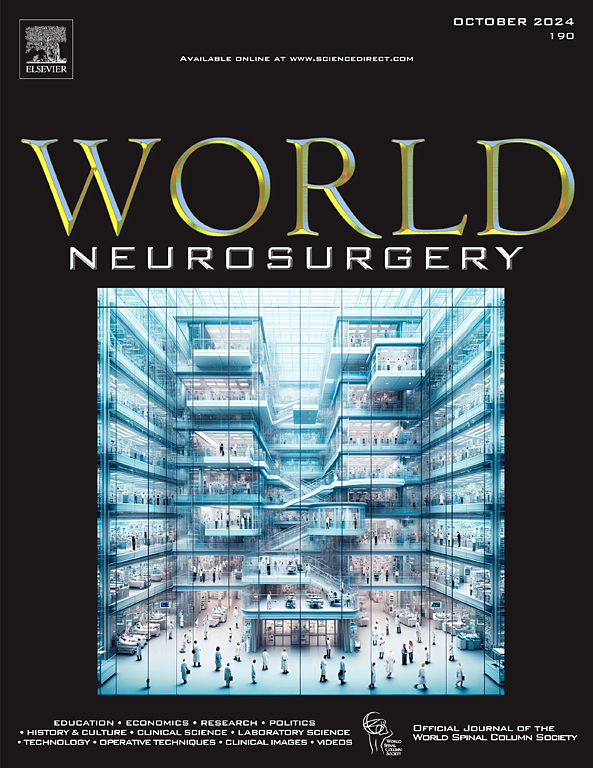Comparing Postoperative Opioid Use in Primary and Revision Lumbar Fusion: A Propensity-Matched Analysis
IF 1.9
4区 医学
Q3 CLINICAL NEUROLOGY
引用次数: 0
Abstract
Objective
This study compared postoperative opioid use for patients undergoing short segment primary versus revision lumbar fusion.
Methods
Patients who underwent primary or revision 1–2 level lumbar fusion (2017–2021) were included in this study. The state Prescription Drug Monitoring Program was reviewed for all patients to quantify preoperative and postoperative opioid, benzodiazepine, muscle relaxant, and gabapentin use. A 1:1 propensity match was performed to match primary lumbar fusion patients with revision lumbar fusion patients. Revision lumbar fusion patients were substratified into those with or without persistent postoperative opioid use to identify demographic differences between these patient cohorts.
Results
The final cohort included 216 primary and 216 revision 1–2 level lumbar fusion patients. The average time between index procedure and revision was 7.54 ± 9.22 years. Opioid use was similar within 1-year preoperatively and at all postoperative time points (up to 1 year) between primary and revision fusion patients. Benzodiazepine, muscle relaxants, and gabapentinoid use was also similar at all preoperative and postoperative time points. Further stratification of revision lumbar fusion patients found that persistent postoperative opioid use patients had a higher incidence of preoperative opioid use within the year prior to surgery with increased number of prescriptions (7.22 ± 7.62 vs. 1.38 ± 2.32; P < 0.001) and morphine milligram equivalents totals (298 ± 565 vs. 45.6 ± 84.4; P < 0.001).
Conclusions
Postoperative opioid requirements were similar amongst patients undergoing primary versus revision lumbar fusion. In the revision cohort, persistent postoperative opioid users had higher preoperative opioid use, which is supported by prior literature. Although revision lumbar fusion has been reported to lead to less pain improvement, this study's findings suggest these procedures may not lead to higher rates of persistent opioid use postoperatively.
比较初次和翻修腰椎融合术后阿片类药物的使用:倾向匹配分析。
目的:本研究比较了短节段初级腰椎融合术与翻修腰椎融合术患者术后阿片类药物的使用。方法:本研究纳入了接受初级或翻修1-2节段腰椎融合术(2017-2021)的患者。对所有患者的PDMP状态进行评估,量化术前和术后阿片类药物、苯二氮卓类药物、肌肉松弛剂和加巴喷丁的使用。采用1:1的倾向性匹配将原发性腰椎融合术患者与翻修型腰椎融合术患者进行匹配。腰椎融合翻修患者被亚分层分为术后持续使用阿片类药物或不使用阿片类药物的患者,以确定这些患者队列之间的人口统计学差异。结果:最终队列包括216例原发性和216例翻修1-2节段腰椎融合患者。从索引程序到修订的平均时间为7.54±9.22年。阿片类药物的使用在术前1年和术后所有时间点(最多1年)在初次和翻修融合患者之间相似。苯二氮卓类药物、肌肉松弛剂和加巴喷丁类药物的使用在术前和术后各时间点也相似。对翻修腰椎融合术患者的进一步分层发现,术后持续使用阿片类药物的患者术前一年内阿片类药物使用的发生率更高,处方数量增加(7.22±7.62比1.38±2.32;结论:术后阿片类药物需求在初次腰椎融合术和翻修腰椎融合术患者中相似。在修订队列中,术后持续阿片类药物使用者术前阿片类药物使用量更高,这得到了既往文献的支持。尽管有报道称腰椎融合翻修术导致疼痛改善较少,但本研究结果表明,这些手术可能不会导致术后持续使用阿片类药物的比例增加。
本文章由计算机程序翻译,如有差异,请以英文原文为准。
求助全文
约1分钟内获得全文
求助全文
来源期刊

World neurosurgery
CLINICAL NEUROLOGY-SURGERY
CiteScore
3.90
自引率
15.00%
发文量
1765
审稿时长
47 days
期刊介绍:
World Neurosurgery has an open access mirror journal World Neurosurgery: X, sharing the same aims and scope, editorial team, submission system and rigorous peer review.
The journal''s mission is to:
-To provide a first-class international forum and a 2-way conduit for dialogue that is relevant to neurosurgeons and providers who care for neurosurgery patients. The categories of the exchanged information include clinical and basic science, as well as global information that provide social, political, educational, economic, cultural or societal insights and knowledge that are of significance and relevance to worldwide neurosurgery patient care.
-To act as a primary intellectual catalyst for the stimulation of creativity, the creation of new knowledge, and the enhancement of quality neurosurgical care worldwide.
-To provide a forum for communication that enriches the lives of all neurosurgeons and their colleagues; and, in so doing, enriches the lives of their patients.
Topics to be addressed in World Neurosurgery include: EDUCATION, ECONOMICS, RESEARCH, POLITICS, HISTORY, CULTURE, CLINICAL SCIENCE, LABORATORY SCIENCE, TECHNOLOGY, OPERATIVE TECHNIQUES, CLINICAL IMAGES, VIDEOS
 求助内容:
求助内容: 应助结果提醒方式:
应助结果提醒方式:


